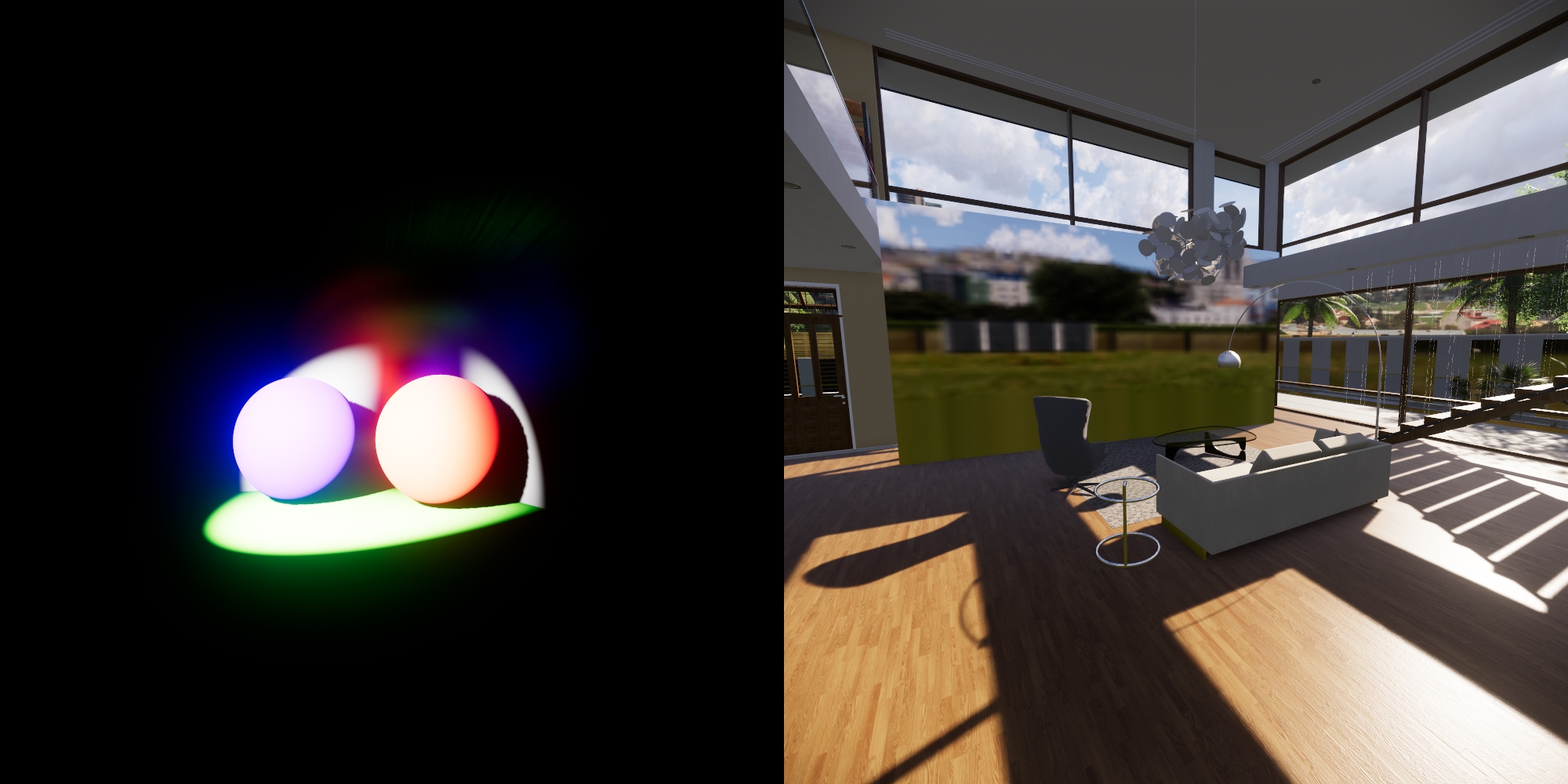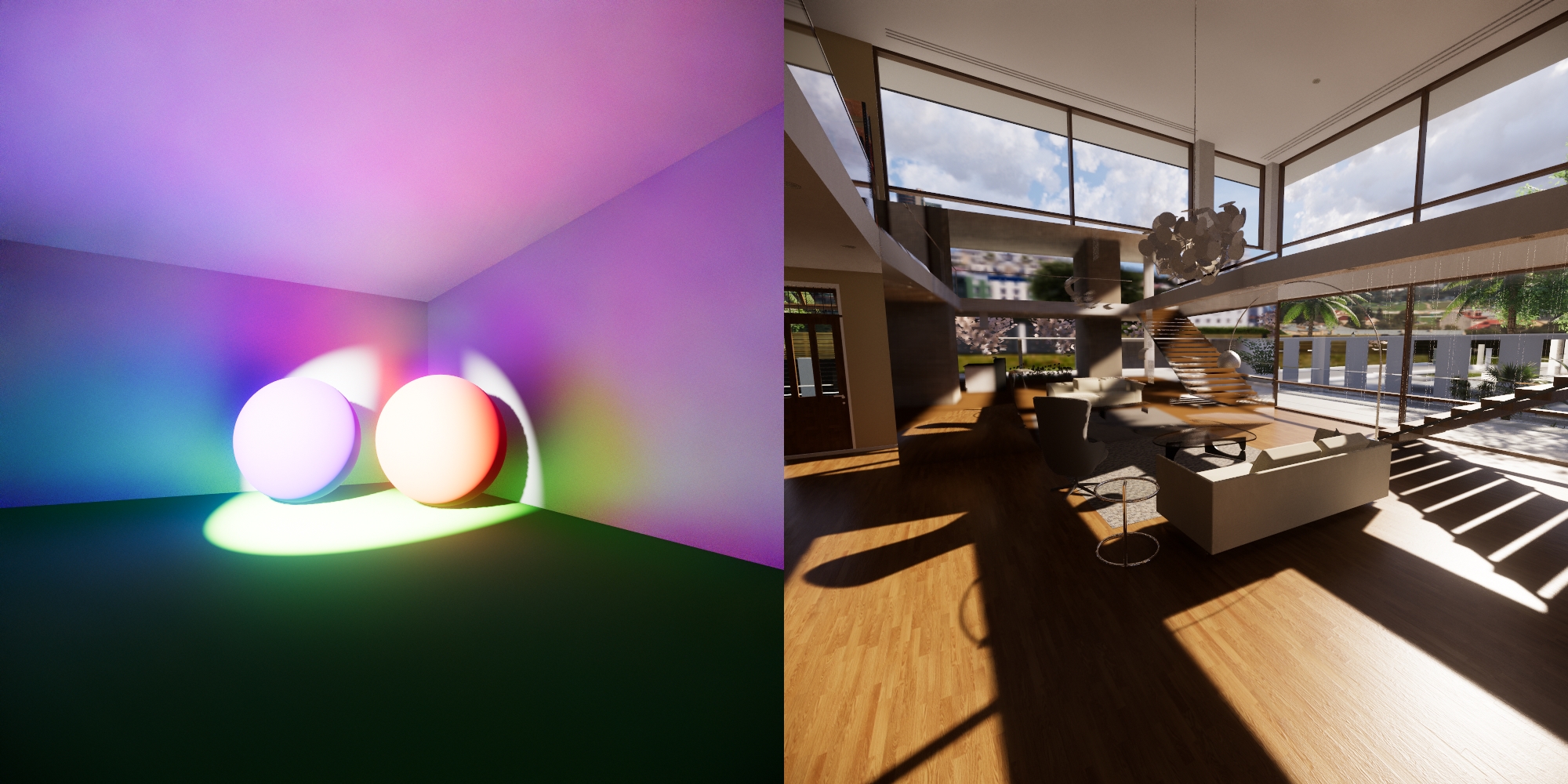Rendering Quality in Enscape
Rendering Quality in Enscape
The Rendering Quality Slider
One of the main goals of Enscape is to allow our users to achieve great results without having to adjust a vast range of settings. This is why Enscape has all the attributes that define the real-time performance condensed into one single slider. Make sure Enscape is running and click on the Visual Settings Window button.

The Visual Settings Window button
The Visual Settings Window will open on the Main tab by default and the Rendering Quality slider is to be found at the bottom of that dialog.

The Rendering Quality setting slider in the Enscape Visual Setting's window
This slider determines how much effort Enscape should put into calculating the lighting in your scene. If you ever experience a low framerate or otherwise bad performance (perhaps because you’re running Enscape on a computer with low level hardware, or a very complex project) setting this slider to a lower setting will result in improved performance.
This setting directly impacts performance when Enscape is rendering in real-time. So what are the available settings, and what do they affect?
Draft
When rendering in Draft mode, only direct light will illuminate your scene. In real life, light will bounce off surfaces, lighting up the environment. With Draft Mode, this process is disabled, ensuring maximum performance in Enscape. Reflections are also affected by this setting and in Draft Mode, reflections will be heavily simplified, showing more of an estimation of the environment of your project than the project itself. This mode, however, apart from granting great performance, can be useful for anybody not interested in lighting their scene at all. You’ll get almost an equal brightness, regardless of where in your project you are, although the result of course won’t look as impressive.

Rendering Quality - Draft
Medium
This is where Enscape begins to show off its impressive Path Tracing abilities. Light will now bump off the first surface it hits, taking information such as the surfaces color and intensity, eventually hitting a second surface and illuminating that too. Reflections will begin to display the actual environment – although Enscape still uses a complex algorithm to determine what objects to display and what to hide according to their size and complexity, as we want to maintain an acceptable frame-rate, after all.

Rendering Quality - Medium
High
Setting the Rendering Quality “High” will improve the aforementioned procedures – lighting is calculated with even more precision, and reflections will hide less objects than on “Medium” setting. Fog looks more realistic when it is lit through complex geometry like vegetation or small holes.

Rendering Quality - High
Ultra
Lastly, the “Ultra” setting. The difference to “High” isn’t all that drastic and is essentially but two bounces of light rays are being calculated instead of just one bounce, resulting in an even more realistic image – but, frankly, you’ll rarely see the difference to the “High” setting at all.

Rendering Quality - Ultra
Other Settings Affecting Real-Time Performance
In addition to the Rendering Quality slider, there exists a set of further options that can affect the performance of your real-time rendering in Enscape. These are located in Enscape General Setting’s ![]() window’s Rendering tab.
window’s Rendering tab.
NVIDIA Global Illumination Denoiser – Improves denoising of ray-traced diffuse and specular global illumination, powered by NVIDIA Real-Time Denoisers (NRD) SDK.
Auto Resolution – Dynamically reduces the resolution to ensure a smooth navigation and frame rate. If deactivated, the native window resolution will be used. This has no effect on rendered export.
Auto Upsampling – Upsampling is automatically activated in case the graphics card runs out of memory during capturing. Disable in case of quality degradation.
Grass/Carpet Rendering – When disabled, a slight performance increase can be had, but carpet and grass will geometry will not be rendered.
Restmode – When enabled, animations will stop a few seconds after you cease movement in the Enscape viewport.

Optional Rendering Performance Settings
The real-time display in Enscape is using a dynamic resolution – the walkthrough is displayed using as higher resolution than the window size and your monitor resolution can allow. However, if Enscape detects your hardware is having difficulties maintaining a decent frame-rate, the Auto Resolution option, if activated, will tell it to downscale the resolution for better performance.
This setting does not affect any render exports, only graphics during your movement through the Enscape scene in real-time!
However, should your scene look blurry in Enscape, you might want to disable this setting to check if that’s the reason – you might have to dial down the Rendering Quality in turn, though.
Render Export Quality Settings
Apart from the mentioned settings, there are also the Resolution settings affecting only the export quality of still image renderings and panoramas, but not the real-time performance.
To be precise, you could probably call the majority of available settings “quality” settings, depending on your personal taste, but the following two settings will improve the output quality while either increasing render time, or output size. The resolution settings are located in Visual Settings window under the Output settings tab.
- General Resolution
Select the export resolution for your still image renderings using this dropdown menu. You can either choose your window resolution, any of the given presets, or a custom resolution up to 8192 x 8192 pixels. Please be aware that exporting renderings in such high resolutions can overwhelm your graphics card, in extreme cases causing Enscape to shut down.
- Panorama Resolution
The Panorama Resolution allows you to choose the quality of the panoramas generated using Enscape. You can choose a resolution from “Low” (2048 x 1024 pixels), “Normal” (4096 x 2048 pixels) to “High” (8192 x 4096 pixels)

The Rendering Export Quality settings

